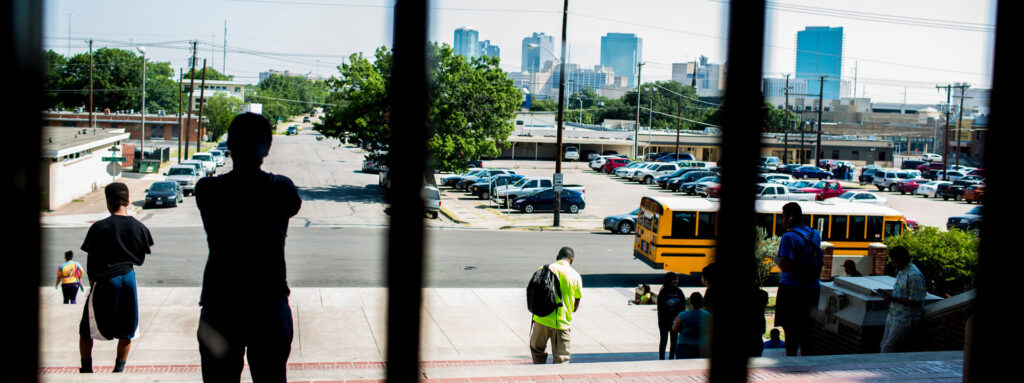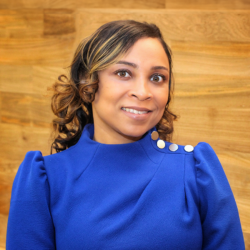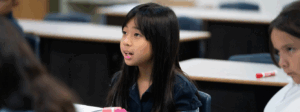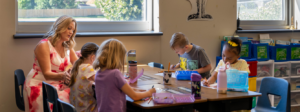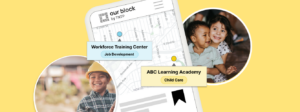As you read this, you may have children banging on the door, a Zoom call running, and dinner heating up in the background. I’m writing this post from my hall closet because it is currently the quietest place in my house and the only space where I can take video calls without my 7- and 4-year-old daughters joining to say hello to their “fans.” The only space left between work, school, and family is a row of sneakers and a rack of winter coats.
This has been an important perspective to bring to our work with school districts during the COVID-19 pandemic. Even as we at TNTP have had a front row seat to the impossible choices facing school systems as they plan for the year ahead, we are experiencing the results of those choices in our homes every day.
For example, this spring was the first time I really got to see what my child was learning in school every day. I didn’t have to glean tidbits from our car ride home from school or wait until the end of the week to read notes from the teacher. My daughter and I were in the trenches together and, for better or worse, I was 100 percent engaged. As empowering as that felt, it was also incredibly frustrating: I had no way of knowing if, say, my multiplication flashcard strategy aligned with our district’s new math curriculum, or if any of our other work at home was helping my daughter learn what she needed to learn.
Almost every family has a story like this from the last few months, whether it’s about the challenges of supporting distance learning, difficulty staying in touch with their child’s teachers, or questions about their school system’s reopening plans. Authentic, 360-degree communication with families has never been more important—which means not only providing clear information about decisions but making sure families’ voices are at the table when those decisions are made.
With support from the Carnegie Corporation of New York, TNTP is collaborating with a diverse cohort of school systems to strengthen their family engagement efforts during this extraordinary moment, and to build meaningful partnerships with families over the long run—partnerships that go beyond conferences and report cards to clear, consistent communication and collaboration that ensures students are on track to reach their goals.
This work is built on the four principles in our theory of action for authentic engagement: shared vision, intentional culture and diversity, authentic collaboration, 360-degree communication. We’re helping our partners survey diverse groups of stakeholders about their priorities for the new school year, share the results for continued input, and launch community conversations and advisory groups to weigh decisions and collect further feedback. We’re also working with teachers toward accelerating student learning in partnership with families, and supporting planning for the very real possibility of school buildings needing to remain closed or close again—in pursuit of a seamless transition of learning between home and school. Here’s just some of what our partner districts are doing to make authentic engagement a reality in their communities:
- Richland Parish, Louisiana, located in the North Louisiana Delta, is a rural district comprised of almost 3,000 students and 11 schools. Superintendent Sheldon Jones is dedicated to engaging with families to advance student achievement. During school closures, the school board offered students the chance to participate in the virtual Summer Learning Academy, with teachers using Google Classroom and other technology platforms to deliver instruction. With a commitment to develop a shared vision, parents provided weekly feedback on this project through a survey. Leadership teams at each school used the feedback to inform their contingency plan for the upcoming school year.
- In Hartford, Connecticut, a diverse district of 20,000 students, principals have continued home visits to connect with students who have been out of touch. Educators are using these visits as an opportunity for authentic communication—to not only deliver information or materials, but understand the barriers that are keeping students and families from being able to access meals, virtual learning, and other services the district is working to provide. Thanks to these and other efforts to make connections and find solutions at the individual student level, Hartford Public Schools has seen more than 80 percent of students engaging with virtual learning.
- In Hamilton County, Tennessee, where tornados ripped through much of the district this winter, the superintendent has reaffirmed his commitment to authentic engagement. “Everyone in the community plays a part in preparing children in our schools for the future,” Dr. Bryan Johnson said. “It is also important to the school district that we are focused on the wishes of the community as we prepare children for success after graduation.” During the pandemic, the school district launched a School Reopening Task Force to begin plans for returning to school. The task force works with staff, parents, students, business leaders, health professionals, and other community members to create a safe plan for reopening school buildings. Using effective practices for 360-degree communication, the district not only launched a stakeholder survey, but invited the public to a virtual panel discussion and Q&A with task force leaders, in which they shared their decision-making process and listened to the concerns of community members.
- Collier County, Florida is a large district. Spanning from the beach destinations of Naples and Marco Island, to Everglades City and nature preserves, the district has experienced firsthand the importance of understanding the unique needs and experiences of individual communities. Coming off recent challenges gaining participation in surveys and input on district plans, leaders pivoted to a strategy focused on intentional culture and diversity. By empowering school leaders to connect with families in ways that felt more relevant to them, Collier County saw participation increase from below 10 to over 60 percent in a matter of weeks. School leaders reached out to families directly via email or phone, and the district provided the survey in multiple languages including Spanish and Haitian Creole.
Over the coming months, we’ll continue to share what’s working and what we’re learning about authentic community engagement in our partner districts. The COVID-19 pandemic—along with the inequities it has exposed and exacerbated, around everything from basic needs to home technology—makes partnering with families more difficult than ever. But those challenges are the very reasons authentic partnership should be a top priority for school systems right now. We can help students get through this crisis and ensure they stay on track to pursue their dreams after high school—but only if families, educators, and school system leaders work together.
